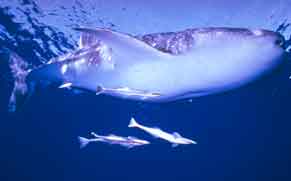
|
|
|
|
|
|
Shark Info (09-15-2000) |
Author |
|
Intro: |
Shark Info |
|
Main article: |
Whale Sharks: Central Theme of the AES Conference in La Paz, Mexico |
Shark Info |
Article 1: |
Shark Info |
|
Article 2: |
Dr. A. J. Godknecht |
|
Article 3: |
Dr. E. K. Ritter |
|
Fact Sheet: |
Dr. E. K. Ritter |
|
Fact Sheet: Whale Sharks
Biology of whale sharks (Rhincodon typus)Whale sharks are the largest sharks of their kind, but despite their size they are completely harmless. Their behavior is characterized by slow swimming movements in their search for food on the water's surface. Unfortunately, exactly this behavior has been the sharks' undoing over the past years for it made them susceptible to easy slaughtering in great numbers. Accordingly, a market was also developed. Once again repulsive finning was the reason these animals had to die. In Taiwan there is a huge market for this shark species which is sold under the name "Tofu shark". Various measures are now under way to protect these animals and several countries have already met with success. However, these animals are very migratory, swimming beyond territorial boundaries, so obviously appropriate agreements for their protection must be concluded with neighboring countries. DescriptionThe animal's basic color is gray, blue or brown with light vertical stripes and white dots over the entire body. Very striking is their horizontal mouth which is not located underneath the snout as with typical sharks (ventral), but rather terminal. Also typical for these animals is an extreme angular head form. Since whale sharks are related to nurse sharks (e.g. Ginglymostoma cirratum), they have relatively small eyes, spiracles and barbels. Size and weightTheir size and weight are a matter of speculation. The longest female ever measured was found stranded near Mangalore (India) and had a length of 12.1 m. The largest male was of the same length and was found near Bombay (India). Photographic indices, however, allow a guess that even larger animals exist. Weight details are barely available. The heaviest speciman ever found (in March 1994) weighed 36,000 kg. FoodWhale sharks are active filterers, meaning they actively suck in water. Their preferred food is plankton which is filtered through the gills. Since the animals prefer plankton bloom they tend to swim in water temperatures between 21°C and 25°C. Although mostly found in deeper water (epipelagic), they have also been observed in atolls and reef regions. In addition to plankton they also eat smaller and larger fish (e.g. sardines, mackerels and even small tuna fish). An interesting fact is that whale sharks often eat while in a vertical position. ReproductionWhale sharks are viviparous, but they have no yolk placenta (aplacentally viviparous). The often found huge egg capsules are simply premature pups. Whale sharks thus do not lay eggs. The offspring are born in the mother's body out of egg capsules. Up to 300 young have been counted in one female. Their size at birth lies between 55 and 64 cm. The females appear to give birth during the entire year because the young have been found both in winter and in summer in single regions. One reason for the low catch in young animals appears to be due to their quick growth. Despite their size, they reach sexual maturity when they have a length of approximately 400 cm. DistributionWhale sharks demonstrate an almost worldwide distribution in tropical and subtropical oceans, both in coastal regions as well as in the open sea. Encounters with humansWhale sharks are harmless and humans can approach them without any risk as long as they avoid molesting them. Special FeaturesWhale sharks are often accompanied by remoras which either actively swim with, or suck themselves onto the whale shark. In addition to their using the shark as a means of transportation, one of their main functions is to remove parasites. Since whale sharks are very large animals, it is very likely that these bony fish also swim into the mouth or spiracle of the whale. Nor is it surprising that they have been seen to look out of the anus. May be published only by indicating the source: Shark Info / Dr. Erich K. Ritter |
|
|
|
|
|
|||||
